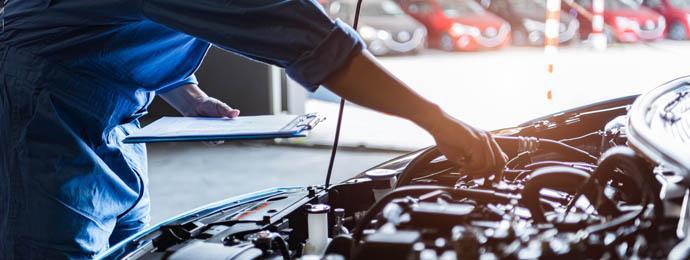Electric Car Maintenance
If you’re thinking of leasing an electric car, chances are you’ll have some questions about its maintenance over the term of your contract, from running costs to how EV maintenance varies from a standard combustion-engine car.
Surprisingly, an electric vehicle's (EV) maintenance is more straightforward than a conventional petrol or diesel engine due to fewer parts. Electric cars require minimal maintenance as there are fewer fluids, such as engine oil. Also, factors like brake wear and tear are significantly reduced as a result of regenerative braking.
To help you understand the maintenance required in leasing an electric vehicle, stock car leasing specialist, Nationwide Vehicle Contracts, has put together a comprehensive guide explaining what's involved in keeping your electric car in excellent condition.

How does electric car maintenance differ to hybrid/petrol/diesel cars?
The word simplicity comes to mind when considering an electric car. Simplistic maintenance is just one of many benefits of electric cars. With significantly less moving parts, electric vehicles have less downtime as there are fewer servicing requirements, especially when compared to traditional petrol or diesel vehicles.
Here's a list of maintenance needs for electric, hybrid and petrol/diesel vehicles:
Electric | Hybrid | Petrol / Diesel | |
|---|---|---|---|
Brakes | |||
Cabin Filters | |||
Clutch | |||
Coolant (Antifreeze) | |||
Engine Air Filter | |||
Engine Oil | |||
Exhaust | |||
Gearbox | |||
Lights | |||
Steering / Suspension | |||
Timing Belts | |||
Tyre Condition | |||
Wiper Blades |
Is an electric car cheaper to maintain?
Leasing an electric car is generally cheaper to maintain than a traditional petrol or diesel car due to fewer moving parts, which means there is less chance of a particular component failing and needing a repair or replacement. With no oil to change and no engine to oversee, it is easy to see why electric vehicles are more cost-effective and easier to maintain.
The most significant saving of owning an electric car is running costs, as electricity is considerably cheaper than traditional petrol and diesel. While electric car owners will save on fuel and tax, it's essential to consider the cost of charging. On a full charge, an electric vehicle can run for 100 miles for around £4-£6 if charging at home and about £8-£10 if using public charging points, according to Energy Savings Trust. In comparison, 100 miles in a petrol or diesel car would cost £13-£16 in fuel.
Buying a 7kW charge point for your home is an excellent investment if you drive an electric vehicle, as you can charge your car a lot quicker than using a regular three-pin plug. Plus, the Electric Vehicle Homecharge Scheme will pay up to 75% of the charge point total cost of £500 in full for eligible vehicles. Read more in our handy EV charging costs and electric car charging points guides.
“Electric vehicles don't require the same maintenance as fuel cars as they have fewer parts. Servicing costs also tend to up cheaper too due to the nature of EV technology.”

What maintenance does an electric car need?
Even though there are considerably fewer parts in an electric car, you still need to take care of your electric vehicle to ensure everything is in working order. The main components that need maintaining on an electric vehicle are the battery, the electrical motor and associated electronics. Conventional parts like brakes, tyres and windscreen wipers also need regular maintenance as any standard vehicle would.
Electric car maintenance essentials include:
- Air Conditioning Filters and Coolant
- Battery Maintenance
- Brake Maintenance
- Light Maintenance
- Tyre care and maintenance of electric vehicles
- Wiper fluid and Blades maintenance
Whether you lease or own an electric car, you will be responsible for the vehicle's essential maintenance and regular checks according to the manufacturer’s guidelines. It's vital to keep your electric vehicle in the best condition as it will reduce the risk of unexpected bills and help lower any chances of an accident due to a fault with the car. Nationwide Vehicle Contracts recommends reviewing the manufacturer's policies throughout the term of the contract.
Air Conditioning Filters and Coolant
Air conditioning is an essential addition to any car; however, it's vital to keep up to date with the maintenance if you want it to perform to its best ability. Air conditioning in electric cars works differently from regular combustion engines. Most electric vehicles use a compressor, similar to one in a domestic fridge, and pulls power from the car's battery pack or storage system.
Air Conditioning Maintenance

Clean car and filters
Bacteria can build up in the working of the car's air conditioning. Looking after your car's interior by cleaning and dusting inside will prevent dirt and debris from accumulating inside.

Keep windows shut
Having your air conditioning on whilst your windows are open is only making the system work harder and will use up coolant and your vehicle's electricity more quickly.

Run air-con weekly
Once a week, turn your air conditioning on and let it run for approximately ten minutes on the coolest setting. Doing this will keep the compressor in tiptop condition, reducing the chance of a mechanical problem from developing.

Keep coolant topped up
Making sure your coolant gets monitored is vital. If the level gets too low, it may need to be drained completely and refilled by a vehicle technician, costing you extra time and expense. Air conditioning coolant has a recommended top up time, every two to three years. We recommend you look at the vehicle owner manual regarding coolant levels and how often they need refiling.
Battery Maintenance
Electric car batteries don't last forever. Like any typical rechargeable battery, they need regular maintenance to ensure a long lifespan.
Electric cars batteries typically last roughly eight years or 100,000 miles; however, this will vary by manufacturer and country. This is because, over time, battery degradation will happen. Battery degradation is a natural process that reduces the amount of energy a battery can store and can affect the vehicle's performance. Once the battery capacity falls below 80%, drivers may start to notice a fall in range and performance. That said, most manufacturers have a five to eight-year warranty on their electric car batteries.
The cost of replacing an electric car battery can be between £3,000-£5,000 depending on the manufacturer; nevertheless, the vehicle's warranty generally covers your batteries lifespan. For example, Nissan has introduced a battery replacement scheme for its electric cars in the UK, including its Nissan Leaf range. The replacement is priced at £4,920, and buyers will also receive £1,000 cashback for their old battery.
You can charge your car's battery at home with a regular three-pin plug; however, it can take up to 6-8 hours for a full charge, according to uSwitch. Charging this way isn't the most efficient way of changing and not the safest either. Using a regular three-pin plug can cause damage to the socket due to the high amperage drawn over a sustained period. It's therefore worth investing in a home charging point. A home charging point costs around £549 to be installed with the government's OLEC grant, which offers up to £500 towards the fee of buying and fitting a home charger. Most energy suppliers also offer discounted or free home chargers with their specialist electric vehicle energy tariffs.
Other factors to help maintain your EV’s battery include:

Keep DC charging to a minimum
Commonly known as "fast charging", DC chargers have a converter inside them, which means it can supply power directly to the car's battery and doesn't need the onboard charger to convert it. DC charging is recommended to be kept at a minimum as overuse can cause the terminal components to overheat. It has also been reported to decrease the battery's lifespan by causing cells to crack and lose storage capacity. For this reason, DC chargers are mostly found on motorway services rather than at home or business locations.

Don’t allow the battery to run out of power
It's essential to make sure your electric car battery doesn't run out entirely. Manufacturers say this can damage the battery and cause cells to deteriorate, and reduce their performance in the long run.

Charge the battery accordingly
Manufacturers advise to not always charge your battery to 100 percent. It is best to only fully charge the battery of your car when going on long journeys. Also, keeping the battery status between 20-80 per cent capacity as it improves your vehicle's battery life performance.
Brake Maintenance
Electric vehicles use regenerative braking, which allows energy that is lost when your car slows down to be converted back into energy for the battery. Regenerative braking is an excellent example of electric cars' benefits and makes braking more efficient, so there's minor wear and tear on your brake system. You will still occasionally have to restore parts such as the brake pads and replace brake fluid.
Brake pads- With an electric car, you will still need to maintain the brake pads. However, thanks to regenerative braking, this is generally much easier to do. Regenerative braking helps avoid the energy loss that occurs when a regular car brakes, so brake pads in electric cars rarely need replacing.
Brake fluids - Even though electric cars do most of their stopping with regenerative braking, they all have standard brake discs and pads. They get pressed together via the same hydraulic fluid found in a conventional car. The hygroscopic fluid tends to absorb water from the air and can corrode your brake system unless you regularly rinse it.
Brake Inspection
How often an electric car needs to be serviced depends on how much you drive, what regeneration settings you use and what terrain you're driving on. Brake inspections involve checking that there is enough brake fluid and to see if it’s in good condition. The pipes that carry the brake fluid will also be checked frequently, and the brake pads also get examined to ensure that they are at the correct depth. All of these components can be replaced if it is considered necessary to do so.
Light maintenance
The lights on your car may not seem the most critical asset, however, it's vital for them to be in perfect condition when driving in harsh conditions or at night. From the lights on your dashboard to your headlights, they all need to be in good shape and working correctly.
Light maintenance

Clean headlights
The best way to keep your headlights in working order is to clean them regularly. Moisture can gather inside the head and tail lights, which hinders the beam strength and appears unsightly.

Never change just one light
If your vehicles bulbs do need replacing, never just replace the one. Always replace bulbs as pairs to avoid one of your lights being significantly brighter than the offer. Remember that the globes in your headlights and tail lights come in pairs. When you return the component, you need to purchase new lights in pairs to retain your light consistency as you drive.

Check the Headlights for Beam Strength
Headlights can lose beam strength over time. Therefore, if you notice any signs of dimness, don't hesitate to take your car to a professional mechanic to check the lights. Dimming indicates that the lights need replacement.
Tyre care and maintenance of electric vehicles
Tyre maintenance is essential for any car. In an EV, its heavy batteries mean tyres may wear down faster due to more accelerating power and additional weight. Tyres must therefore be checked thoroughly on electric cars for signs of low tread, tears, delamination and other defects. Checking for proper wheel-balancing, alignment and rotating the tyres will also make them last much longer.
Generally, most tyres are recommended to drive for around 20,000 to 30,000 miles. Tyres that are ten years old should be replaced to ensure your car is safe to be on the road. For more help and advice on tyre care and maintenance, read our handy Tyre Type and Classification guide.
Do electric cars damage regular tyres more?
The stand out factor between electric cars and standard combustion engine vehicles is the weight. The requirement for a larger, heavier battery means electric car tyres wear a lot quicker. The pressure of the increased weight means a regular tyre on an electric car won't last as long or meet the vehicle's demands while out on the road.
Electric car tyres vs conventional tyres comparison
Electric Tyres | Conventional Tyres |
|---|---|
They last longer | Wear 30% quicker than electric vehicles |
More expensive compared to regular tyres | They're cheaper than EV tyres |
Wiper fluid and blades maintenance
Electric cars' wiper blades are just as liable to breaking as on a standard vehicle. It's vital to check your wiper blades regularly before and whilst driving to make sure they're working correctly. You also need to keep wiper fluid topped up just as much. You can check by sight for wear and tear of the blade, and symptoms include looking cracked, dry, misshapen or stiff. The wiper blade arm can get damaged only through general use over time. The component is recommended to be replaced every six to twelve months. Wiper blades and fluid are straightforward to change and keep topped up and can be found in most car part retailers.
Do electric cars need servicing?
An electric car needs to be serviced as often as a conventional car, however, we recommend checking your owner's manual for the manufacturer's service schedule. Since an electric vehicle has fewer parts than a regular petrol or diesel motor, there are more periodic inspections during the service and typically require needless repairs.
When it comes to getting your electric vehicle serviced and repaired locally, some mechanics might be unfamiliar with working on electric motors. Nationwide Vehicle Contracts offers a maintenance contract when leasing an electric vehicle, which includes all service scheduling, replacement tyres, MOT and other repair costs that may be required during the term of the contract. Plus, any work on your vehicle will also be carried out by qualified technicians at accredited garages, so you can rest assured that your car is in safe hands.

How often should you service an electric car?
Usually, your car should be serviced once a year or every 10,000-12,000 miles, the same as a standard combustion engine vehicle. It is advised to check the manufacturer's guidelines for your specific vehicle. A full service is highly recommended, although an essential service will help keep it running smoothly if the car is regularly serviced. Features like regenerative braking, for example, means the car's brakes don't wear down as quickly due to the electric motor's reduced action. This means that the friction brakes are hardly applied. Thanks to the electric cars remarkable engineering, there's not much to check when servicing the vehicle. However, there can be updates or upgrades for things like the infotainment system and other software requirements.
As mentioned earlier, electric motors require minor servicing, thanks to a handful of bearings taking the brunt of the wear and tear. Tesla recommended maintenance service:
Cabin air filter | Every two years |
|---|---|
High-efficiency particulate filter | Every three years |
Brake fluid test | Every two years |
Air conditioning | Between two and six years |
Overall, electric vehicles work out cheaper to service and maintain than traditional petrol and diesel models due to having fewer moving parts and fewer items susceptible to wearing out over time. The cost of servicing your car depends on the service provider and the manufacturer. The Renault Zoe, for example, works out at around £1,100 in servicing and maintenance over three years.
Do electric cars need an MOT?
Like any traditional vehicle, electric cars have to pass an MOT after they are three years old. If your car passes its test, then a certificate will be issued, and this lasts for one year. The MOT process is slightly different as there is no need to change fluids such as engine oil or transmission fluid as an electric vehicle doesn't have a combustion engine but is still an important test as it ensures your vehicle is safe on the road.
Electric Car MOT

1. Record MOT
The vehicle is recorded onto the official MOT test system, however, unlike a conventional petrol or diesel car, no emissions checks are needed on electric cars.

2. Headlights, wipers and horn
All lights on the vehicle including the headlights, brake and taillights, fog lights and hazard are checked to make sure they're working, are the right brightness and are aligned correctly. The vehicle's wiper and horn are also checked as faulty items could result in a failed MOT.

3. Seatbelts and safety
Next, mechanics will check the seatbelts, windscreen wipers and examine the windscreen for cracks or chips.

4. Mechanics and steering
The mechanical components on the vehicle are checking including the steering system, suspension, shock absorbers and wheel bearings to make sure they're working properly and all the wheels are spun to check for any excess wear and tear.

5. Corrosion and rust
The vehicle is inspected for corrosion. The components are checked for rust, including those under the bonnet and those underneath the car. The car's chassis, mounting brackets, sills and hinges are checked to make sure everything is in good condition.

6. Braking system
A brake test is then conducted to decide whether mechanical elements need fixing or replacing - for example, the discs or brake pad.

7. Electrical systems
Finally, the car's electrical systems, including the electric motor's battery health and condition will be checked to ensure they're working safely.
Once a vehicle reaches the third anniversary of its registration, an MOT test is mandatory. If your car passes its MOT, then a certificate will be issued, and this lasts for one year. The MOT makes sure your vehicle can meet roadworthiness and environmental requirements.
Is the maintenance of my electric car covered with my lease contract?
Your lease agreement will indicate who must pay for maintenance and repairs during the lease term. Also, the contract should come with a manufacturer's warranty. Ideally, it will cover the entire length of the lease and the number of miles you are likely to drive.
Nationwide Vehicle Contracts offers a fantastic maintenance package when it comes to leasing an electric vehicle. For a fixed monthly fee, a vehicle maintenance contract includes all scheduling servicing, replacement tyres, MOT and other repair costs (exclusions apply) required during the term of the contract.
Want to know more about electric or hybrid car leasing?
With lower CO2 emissions, quieter engines and huge savings on road tax and maintenance now could be the perfect time to lease an electric car and drive off in something fit for the future. For more information on electric cars, check out our electric car guides or view our range of electric car leasing deals with personal and business contracts available.
Guide Information
Originally published: 5th March 2021
Last updated: 5th March 2021
